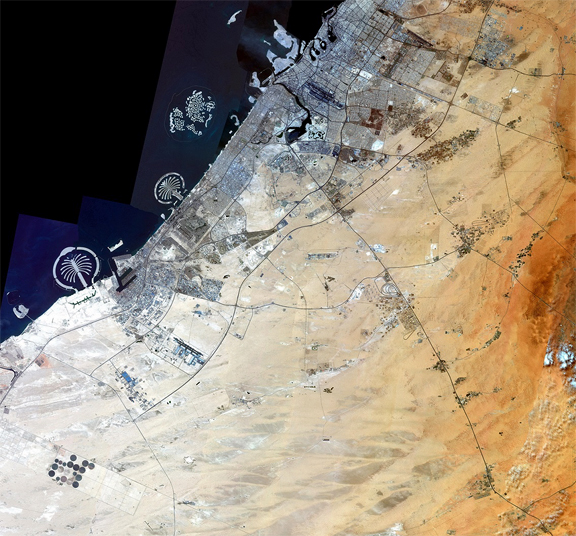[SatNews] The Emirates Institution for Advanced Science and Technology (EIAST) celebrates on Friday, November 21st, 2014, the one year anniversary of the launch of DubaiSat- 2 from the Yasny Launch Base in Russia, using the Russian Dnepr rocket launcher in cooperation with the Russian International Space Company (Kozmotras).

Satellite mosaic imagery of Dubai.
Image is courtesy of EIAST.
On this occasion, EIAST released a mosaic image of the entire Emirate of Dubai at a resolution of one meter. The mosaic image is comprised of 10 satellite photos taken by DubaiSat-2 as it passed over Dubai when conditions were optimal and under varying circumstances. The image will be updated every six months to track the development of environmental projects, urban planning, infrastructure and other projects.
DubaiSat-2 consists of two main segments—the DubaiSat-2 Space Segment, which consists of a spacecraft bus and an electro-optical payload that contains a push-broom camera with TDI sensors to provide space images, while the DubaiSat-2 Ground Segment includes the Main Mission Control Station (MCS), Subsidiary MCS, Main Image Receiving and Processing Station (IRPS), and Antenna system. Dubai Sat-2 weighs 300kg and is 2 meters high and 1.5 meters wide. The satellite is equipped to provide space imagery of the entire world throughout its lifetime and can take multiple images of the same area in one day, as well as receive and process these images from anywhere in the world within one day.
The satellite is equipped with innovative technology to enhance the maneuvering capability and increase its agility by 300 percent, as compared to Dubai Sat-1. It is equipped with a propulsion system that allows the control of its altitude above ground level and modifies it automatically in the event of any deviation from the orbit through a set of predetermined and saved commands sent from the control station. The satellite makes one full orbit around the Earth in 96 minutes, with 60 percent of its time facing sunlight. The satellite aims to provide electro-optical images at a resolution that reaches one meter to be used in several civilian applications, such as providing 3D images, update project development in various fields including urban planning and urban development, scientific research, civil engineering and environmental projects, construction and geological mapping and research, in addition to providing specialized reports.
EIAST was established by the Dubai Government in 2006 to encourage scientific innovation and technological progress in Dubai and in the UAE. It also aims to develop the scientific skills and knowledge of Emiratis. It is mainly involved in outer space research and development; satellite manufacturing and systems development; space imaging; and ground station services and support for other satellites.
The EIAST infosite has additional information at http://www.eiast.ae